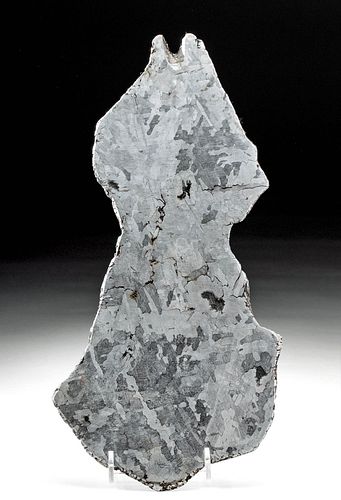Fine Campo del Cielo Meteorite Slab
Lot 107b
About Seller
Artemis Gallery
686 S Taylor Ave, Ste 106
Louisville, CO 80027
United States
Selling antiquities, ancient and ethnographic art online since 1993, Artemis Gallery specializes in Classical Antiquities (Egyptian, Greek, Roman, Near Eastern), Asian, Pre-Columbian, African / Tribal / Oceanographic art. Our extensive inventory includes pottery, stone, metal, wood, glass and textil...Read more
Categories
Estimate:
$1,500 - $2,000
Absentee vs Live bid
Two ways to bid:
- Leave a max absentee bid and the platform will bid on your behalf up to your maximum bid during the live auction.
- Bid live during the auction and your bids will be submitted real-time to the auctioneer.
Bid Increments
| Price | Bid Increment |
|---|---|
| $0 | $25 |
| $300 | $50 |
| $1,000 | $100 |
| $2,000 | $250 |
| $5,000 | $500 |
| $10,000 | $1,000 |
| $20,000 | $2,500 |
| $50,000 | $5,000 |
| $100,000 | $10,000 |
| $200,000 | $20,000 |
About Auction
By Artemis Gallery
Oct 8, 2020
Set Reminder
2020-10-08 10:00:00
2020-10-08 10:00:00
America/New_York
Bidsquare
Bidsquare : Exceptional Antiquities, Asian, Ethnographic
https://www.bidsquare.com/auctions/artemis-gallery/exceptional-antiquities-asian-ethnographic-5796
Museum-worthy examples of Egyptian, Greek, Roman, Etruscan, Near Eastern, Far East / Asian, Pre-Columbian, African / Tribal,Oceanic, Native American, Spanish Colonial, Russian, Fossils, Ancient Jewelry, Fine Art, so much more! Artemis Gallery info@artemisgallery.com
Museum-worthy examples of Egyptian, Greek, Roman, Etruscan, Near Eastern, Far East / Asian, Pre-Columbian, African / Tribal,Oceanic, Native American, Spanish Colonial, Russian, Fossils, Ancient Jewelry, Fine Art, so much more! Artemis Gallery info@artemisgallery.com
- Lot Description
South America, Argentina, Campo del Cielo, ca. 4.5 billion years old. A fine, iron-rich slab from a massive and extremely heavy meteorite from the world-renowned impact site at Campo del Cielo (also Piguem Nonralta) in Argentina. The 22 plus craters from this 5,000-year-old collision with a giant space rock were discovered by Europeans around 1576, but were well known by the local inhabitants. In all, over 100 tons of meteorites have been recovered making this the largest meteorite field on record. Size: 13.3" L x 6.375" W (33.8 cm x 16.2 cm); total weight: 997.9 grams.
This meteorite also played an interesting role in human history. It provided iron to indigenous people in the region and the Spanish colonists in the area took notice. In 1576, the governor of the province of northern Argentina sent out a military search party to locate the source of the natives' iron weapons. However, it was not until the late 1700s that early natural scientists began to understand the true source of the iron. In 1783, Ruben de Celis used dynamite to clear the area around the craters and discovered that it was not a mine, as previously suspected, but was instead the remains of a single huge mass. Believing the source to be a volcanic eruption, he sent a sample to the Royal Society in London, where it was found to be 90% iron and 10% nickel and thus from a meteor.
Provenance: private Hagar collection, Wildwood, Missouri, USA
All items legal to buy/sell under U.S. Statute covering cultural patrimony Code 2600, CHAPTER 14, and are guaranteed to be as described or your money back.
A Certificate of Authenticity will accompany all winning bids.
We ship worldwide and handle all shipping in-house for your convenience.
#159363This is a slice from a larger meteorite. Minor nicks and roughness around peripheries, with one perforation through narrow area of body, otherwise intact and excellent. Great patina and luster throughout.Condition
- Shipping Info
-
All shipping is handled in-house for your convenience. Your invoice from Artemis Gallery will include shipping calculation instructions. If in doubt, please inquire BEFORE bidding for estimated shipping costs for individual items.
-
- Buyer's Premium



 EUR
EUR CAD
CAD AUD
AUD GBP
GBP MXN
MXN HKD
HKD CNY
CNY MYR
MYR SEK
SEK SGD
SGD CHF
CHF THB
THB














